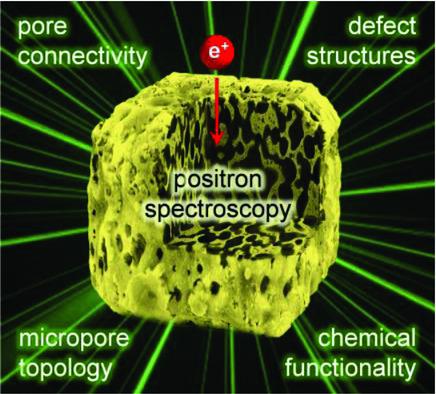当前位置:
X-MOL 学术
›
Small Methods
›
论文详情
Our official English website, www.x-mol.net, welcomes your feedback! (Note: you will need to create a separate account there.)
Shedding New Light on Nanostructured Catalysts with Positron Annihilation Spectroscopy
Small Methods ( IF 12.4 ) Pub Date : 2018-09-25 , DOI: 10.1002/smtd.201800268 Sharon Mitchell 1 , Lars Gerchow 2 , Robbie Warringham 1 , Paolo Crivelli 2 , Javier Pérez‐Ramírez 1
Small Methods ( IF 12.4 ) Pub Date : 2018-09-25 , DOI: 10.1002/smtd.201800268 Sharon Mitchell 1 , Lars Gerchow 2 , Robbie Warringham 1 , Paolo Crivelli 2 , Javier Pérez‐Ramírez 1
Affiliation

|
Interest in new tools for the analysis of catalytic materials is growing due to the potential to enhance their functionality through the optimal nanostructuring, for example, of pore networks and surface properties. This prompts the need for improved descriptors to discriminate increasingly complex architectures. As a nondestructive, dynamic, and potentially, temporally, and spatially resolved tool, positron annihilation spectroscopy (PAS) can provide valuable complementary insights to already established (e.g., adsorption, spectroscopy, diffraction, and microscopy) methods. This is possible due to the specific sensitivity of positrons to the electronic environment, which determines their annihilation characteristics. However, despite growing enthusiasm, PAS is not widely known in the catalysis community. This review aims to highlight the many unique features, principles, and potential pitfalls of the technique, expanding on the outdated reviews on the topic, which are now over a decade old. After briefly introducing the principles, progress in the application of PAS to investigate various features of relevant catalytic materials is summarized. This includes the crystalline structure, presence of defects, pore connectivity and evolution, chemical properties, and adsorption phenomena. An improved understanding of the response will contribute not only to guiding the design of nanostructured materials but also to positioning PAS as a mainstream method for catalyst characterization.
中文翻译:

正电子ni没光谱法为纳米结构催化剂提供了新的思路
由于有可能通过最佳的纳米结构(例如,孔网络和表面特性)来增强其功能,因此人们对用于催化材料分析的新工具的兴趣正在增长。这促使需要改进的描述符来区分日益复杂的体系结构。作为一种非破坏性,动态的,潜在的,时间上和空间上可分辨的工具,正电子an没光谱法(PAS)可为已经建立的方法(例如,吸附,光谱,衍射和显微镜)提供有价值的补充见解。由于正电子对电子环境的特定敏感性决定了它们的an灭特性,因此这是可能的。然而,尽管热情越来越高,但PAS在催化界并未广为人知。这篇综述旨在突出该技术的许多独特功能,原理和潜在的缺陷,并在此主题已经过十年的过时评论的基础上进行了扩展。在简要介绍了原理之后,总结了PAS在研究相关催化材料的各种特性方面的应用进展。这包括晶体结构,缺陷的存在,孔的连通性和演化,化学性质和吸附现象。对响应的更好理解将不仅有助于指导纳米结构材料的设计,而且还将有助于将PAS定位为催化剂表征的主流方法。在简要介绍了原理之后,总结了PAS在研究相关催化材料的各种特性方面的应用进展。这包括晶体结构,缺陷的存在,孔的连通性和演化,化学性质和吸附现象。对响应的更好理解将不仅有助于指导纳米结构材料的设计,而且还将有助于将PAS定位为催化剂表征的主流方法。在简要介绍了原理之后,总结了PAS在研究相关催化材料的各种特性方面的应用进展。这包括晶体结构,缺陷的存在,孔的连通性和演化,化学性质和吸附现象。对响应的更好理解将不仅有助于指导纳米结构材料的设计,而且还将有助于将PAS定位为催化剂表征的主流方法。
更新日期:2018-09-25
中文翻译:

正电子ni没光谱法为纳米结构催化剂提供了新的思路
由于有可能通过最佳的纳米结构(例如,孔网络和表面特性)来增强其功能,因此人们对用于催化材料分析的新工具的兴趣正在增长。这促使需要改进的描述符来区分日益复杂的体系结构。作为一种非破坏性,动态的,潜在的,时间上和空间上可分辨的工具,正电子an没光谱法(PAS)可为已经建立的方法(例如,吸附,光谱,衍射和显微镜)提供有价值的补充见解。由于正电子对电子环境的特定敏感性决定了它们的an灭特性,因此这是可能的。然而,尽管热情越来越高,但PAS在催化界并未广为人知。这篇综述旨在突出该技术的许多独特功能,原理和潜在的缺陷,并在此主题已经过十年的过时评论的基础上进行了扩展。在简要介绍了原理之后,总结了PAS在研究相关催化材料的各种特性方面的应用进展。这包括晶体结构,缺陷的存在,孔的连通性和演化,化学性质和吸附现象。对响应的更好理解将不仅有助于指导纳米结构材料的设计,而且还将有助于将PAS定位为催化剂表征的主流方法。在简要介绍了原理之后,总结了PAS在研究相关催化材料的各种特性方面的应用进展。这包括晶体结构,缺陷的存在,孔的连通性和演化,化学性质和吸附现象。对响应的更好理解将不仅有助于指导纳米结构材料的设计,而且还将有助于将PAS定位为催化剂表征的主流方法。在简要介绍了原理之后,总结了PAS在研究相关催化材料的各种特性方面的应用进展。这包括晶体结构,缺陷的存在,孔的连通性和演化,化学性质和吸附现象。对响应的更好理解将不仅有助于指导纳米结构材料的设计,而且还将有助于将PAS定位为催化剂表征的主流方法。



























 京公网安备 11010802027423号
京公网安备 11010802027423号